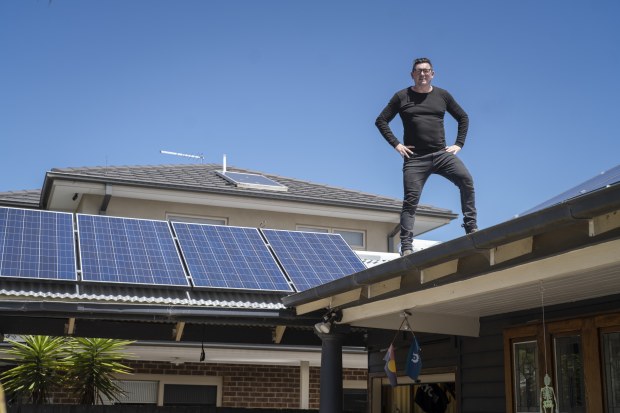Smart ways to get the most out of your solar
Homeowners are using tips and tricks to shift as much of their power usage as possible to solar.
Melbourne homeowner Danny Cash keeps a close eye on his electricity smart meter when he’s at home during the day to see if his appliances are all running on solar power, or if he is also buying power from the electricity grid.
“I am very conscious of my energy usage and what times of the day I’m running appliances,” says Cash, a family law barrister who lives with his wife and two children in Melbourne’s Kingsville.

Melbourne homeowner Danny Cash has got his electricity bill to under $5 a day. Eamon Gallagher
He is one of many Australians with solar panels who are shifting as much of their power usage as possible to daylight hours when their solar panels are generating, instead of having to buy power from an electricity retailer during the evening. Doing so is an alternative to using home batteries, which are expensive and developing technology.
The family has solar hot water and tries to run the dishwasher and washing machine during the day, and Cash keeps an eye on the smart meter.
“It’s got a little arrow that tells you if you’re importing or exporting energy,” he says. “If it looks like I’m importing during the day, I switch off an appliance, wait until the washing machine ends and then put on the split-system air-conditioning.”
Cash has removed gas from his home and electrified it instead. The family’s electricity bill comes to less than $5 a day, he says.
When they become available, he plans to buy an electric car with a battery that can also discharge power for home use.
Smart homes, smart meters
Rachel Goldlust, a researcher at Renew, which aims to help people live sustainably, says home battery technology hasn’t yet advanced to a point where large numbers of people are prepared to buy one. Instead, they are holding off until later.
She says the increasing number of Wi-Fi connected appliances is making it easier for homeowners to switch on and off or to pre-program appliances to make maximum use of their solar power.
People who buy solar panels are generally very interested in making the best use of them, Goldlust says. She also suggests people contact their power providers to see which tariffs will best suit their usage patterns.
Tim Forcey, a Victorian energy consultant, expects more households to adopt batteries in future, but says they are currently uneconomic.

Energy consultant Tim Forcey says hot water heaters can be used as substitutes for batteries.
He suggests homeowners use their hot water heaters as substitutes for batteries. They should use solar panels to heat water during the day instead of taking power from the grid during the night. The electricity is stored as hot water until it’s needed for showers or washing.
“We call it a thermal battery,” he says. “It’s the cheapest hot water in the world.”
Heat-pump water heaters draw heat from the outside air and so only use about a quarter of the electricity of traditional hot water heaters and charge in about three hours. They use only 800 watts compared with about 4000 watts for traditional heaters, which allows homeowners to do other things such as a load of washing at the same time as the hot water pump is operating. It also means they can potentially be charged on a cloudy day.
While they can be costly to buy, some state governments offer incentives to do so. However, Forcey warns people to be careful of companies offering deals that look too good to be true.
For owners of traditional hot water heaters, known as electric resistive heaters, Forcey suggests they get a power diverter, which can determine whether a household is exporting electricity to the grid and if so divert the power to the hot water system.
Diverters can also be used for charging electric cars, directing the power to the car battery if there is excess going to the grid, Forcey says.
Finn Peacock, an engineer and environmentalist, said that with many power companies paying a feed-in tariff of between 5¢ and 10¢ per kWh, it makes more financial sense for solar panel owners to use their power rather than sell it.
One strategy is to run the air-conditioning during the day, even if people aren’t home. For instance, the air-conditioning can be put on a timer to come on at 2pm when the sun is generating power, which means the house is cool when people arrive home later, and they don’t need as much power for cooling during the evening.
However, Peacock says the effectiveness of the strategy is dependent on how well insulated the home is.
On average, Australians drive about 40 kilometres per day and so many electric cars would require just one charge per week, which can be done during the day or on weekends rather than during the evening, Peacock says.
Introducing your Newsfeed
Follow the topics, people and companies that matter to you.
Find out moreRead More
Latest In Energy & climate
Fetching latest articles